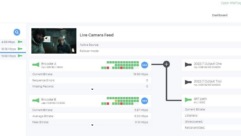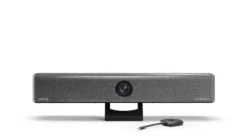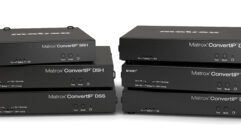
Audio | Flatscreens | Presentation, Conference & Video Systems | Projectors |
Pete Putman’s Show Summary | Exhibitor & Attendee Reactions
Folsom Research showed their ScreenShaper video mapping system, which allows curved screen panoramic projection for immersive environments. Similar software was seen in other booths, although it wasn’t as powerful as the Folsom demo.
Extron rolled out their IP Link line of interfaces during the show. These boxes provide IP to RS-232C conversion and can be used with any AV equipment that employs an RS-232C interface. Three new scan converters (VSC 500/700/900) also took a bow, as did the BBG 6A blackburst generator. On the test equipment front, the VTG-300 is a complete overhaul of the older VTG200 and offers 31 video output rates and numerous test patterns – plus it’s battery-powered.
Incidentally, several companies showed similar IP-to-RS232C converters on the show floor. Christie debuted ChristieNET projector management and control solutions to connect any Christie projector to any windows-based network enabling AV control and monitoring anywhere around the world. ChristieNET is available in Expanded, Enterprise and Projector Organizer models. Sharp’sAN-LS1 is another Ethernet to RS-232C converter that does pretty much the same thing, and of course Mitsubishi continues to sell the ProjectorView interface modules. All of these systems (and hybrids) support legacy projectors and displays.
Vista Systems had a nice demo of their Montage multi-channel seamless video mixing/switching system. It can handle up to 12 overlaid channels and also transition between seamless panoramic video and graphics. And Silicon Optix showed a brand-new video scalar that incorporates their image reshaping technology for off-axis projection.
Kramer somehow figured a way to make an even lower-cost video scalar, the VP-719DS. It accepts everything from VGA to UXGA (even DVI) and converts to five PC and six non-standard display rates to best match fixed-pixel imagers. For more power, there’s the VP-724DS, which improves on last year’s model with additional video and audio connectivity. In addition to PC and flat-panel output rates, it also supports 480p, 720p, and 1080i.
Astro Systems announced a new portable video signal test generator, the VG-848. It can crank out signals to QXGA (2048×1536) and also tests HDCP, plus it supports component, composite, and DVI interfaces. Gefen showed a clever system of building-block DVI distribution amplifiers (who says you can’t split DVI?).
Analog Way declared it would provide three different Graphic Switcher II bundles for event and installation needs. In addition, the new Octo-Logo was displayed. It’s a high-resolution logo inserter and seamless switcher for conference rooms and boardrooms. Up to 8 logos can be stored in memory, and each logo can be positioned anywhere on the screen (using fully adjustable H&V logo position) and distributed to any of the 8 universal inputs as a matte image or keyed over another image.
Magenta Research showed off the MultiView 1500 Receiver. This receiver is fully compatible with MultiView 450 products and can pipe a UTP-converted XGA (1024 x 768) signal with 75Hz refresh up to 1,500 feet, while a UXGA (1600 x 1200) source with 75 Hz refresh is good to 1,000 feet.
RGB Spectrum showcased the DGx Model 102 dual-channel high-resolution recording system. It can capture, compress, store, and play back imagery at up to 1600 x 1200 pixel resolution. Recordings are time stamped and may be event-marked for random access. RGB’s DSS option provides 9- or 15-hour recording capacity on removable hard drives.
Advanced Media Design
introduced MediaPOINTE ™ System One and System Two scaleable conferencing systems.MediaPOINTE allows any media source, or combination of sources to be displayed by the operator on a full screen, in multiple windows on the screen or on multiple screens. The systems can share, annotate, or collaborate on any media source with a remote site, in real time, automatically, by pointing at its image using the wireless mouse or touch panel.
Hitachi’s Interactive Communications Group introduced the StarTablet™ T-18SX interactive 18” TFT device with SXGA quality graphics. The StarTablet and its associated software permit presenters to run and annotate computer applications, while simultaneously displaying the annotated images on rear projection or plasma displays, or traditional screens using LCD projectors. The annotated data can be saved in several file formats including .html files for easy viewing with any web browser software.
Smart Technologies introduced the Rear Projection SMART Board™ 2000i interactive white board designed for the education market. The 2000i ships with an installed SVGA (800x 600), 1600-lumen projector with an option to upgrade to an XGA (1024 x 1280), 2500 –lumen projector. Provided with the system is a built in audio system, integrated projector controls and a bottom tray for computer and peripheral storage.
iMATTE Inc. launches iSkia (Greek for The Shadow) a hardware device that interfaces between the host computer and projector. iSkia generates a mask to selectively inhibit the projected image. It allows the image to be projected on the screen but not on the presenter or in the presenter’s eyes. iSkia requires no special software on the presenter’s computer, works with any projector, and is interactive.
Polycom introduced ViewStation EX. Provides High Resolution data collaboration and features an embedded dual 10/100 Ethernet switch. Supports up to 768 kbps calls over IP and up to 512 kbps ISDN and Serial modules.
Intelix introduces Event Scheduling Software for Intelix M Series E audio/video matrix mixers. It is a unique software solution for hands-free audio programming and control in rapidly changing environments.
Intelix Event Scheduling Software works in conjunction with Intelix M Series Designer Software, allowing facility managers to program repetitive or unique events—without the need for manual control or secondary control apparatuses—in a platform similar to standard PDA scheduling software. When combined with connectivity options of Intelix audio/video matrix mixers, Intelix Event Scheduling Software can be used to facilitate remote monitoring and diagnostics.
Omnimount Systems introduced two new Universal Projector Mounts, the PMD-1 for small DLP projectors and the PMD-2 for larger LCD projectors. These mounts are compatible with most projectors weighing less than 30lbs and can be mated to any of OmniMount’s 20.0, 20.5, or 30.0 series of brackets. The Universal Projector Mounts are manufactured with a sturdy steel construction and finished with an electrostatic powder coating.
Electrosonic showed the DIRECTOR™, a network-enabled display processor, designed to access, manage, control and display multi-media information sources. DIRECTOR provides for the simultaneous display of multiple real-time graphics and video sources on single, dual, or quad high-resolution digital displays.
Clarity Visual Systems debuted WallNet, a hardware and software networked solution that enables both interactive and automated status and health monitoring of Clarity displays. WallNet uses standard Internet technologies combined with Clarity’s RS-232 control capability.
Crestron introduced a range of products, collectively known as Crestron Media Manager™. The product line is a combination of technologies designed to integrate AV device control, facility wide management, signal switching and routing in a single family of products.
Middle Atlantic Products introduced its custom LCD rack mount system The new mounts captivate monitors using VESA 75 and VESA 100 mounting hole patterns while custom-cut bezels, which are available with anodized or textured finishes, trim the monitors’ face for situations where appearance is critical. The LCD mounts can accommodate most monitors up to 17” in diagonal size. In addition to the rear bracket VESA 75 and VESA 100 mounting hole patterns, an adjustable rear clamp provides further support when shorter or smaller monitors are being installed.










